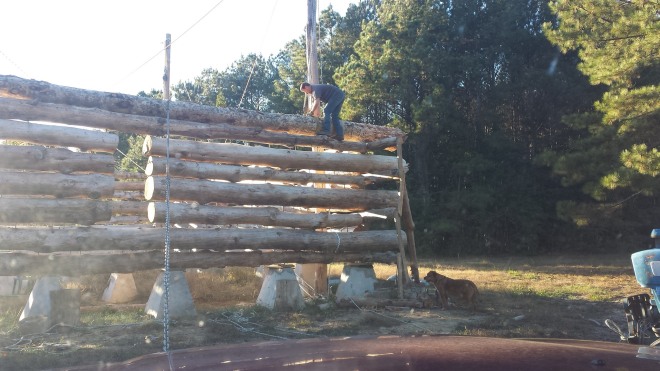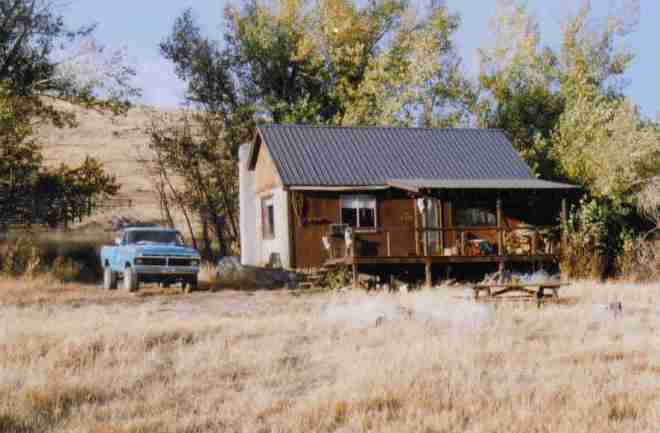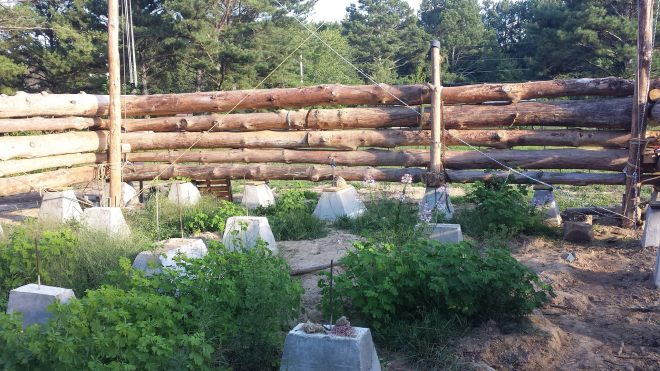Shipping Container
How to store your stuff
From the beginning, we’ve worried about our stuff getting stolen. So far, I’ve lost a critter cam that was aimed at my tractor, some gas cans, some tow chains and two chain binders. I think it’s a theft of convenience. Our property backs up to some woods, and the woods back up to someone’s backyard, and beyond that is a trailer park. Our neighbor says that people have been walking from the trailer park through our property and on over to another neighborhood. I think some of them are thieves looking for easy pickings, but I can’t imagine the use of two chain binders, unless you’re a trucker or building a log home.Many folks build a garage as their first project. Then they store their tools while they build their house. I wanted to build faster so we could move there ASAP. I considered building a shed, but that would require a permit and a foundation. A fence would only stop people who can’t climb. I needed something I can lock. We are at the point where we have some expensive stuff about to be left overnight- like a sawmill, and building materials.
I’ve seen ads for shipping containers for years, but they can be a little pricey in my estimation:

All the ones I’ve seen for under $2,000 are also 20′ long or less. My plans call for 26′ rafters, so I needed at least a 40′ shipping container if I was going to use it for storing rafters.
I need 32 rafters, 4″x12″, and 26′ long. The shipping container is 8.5′ tall and 8.5′ wide. I can get 12 in a row in a space only 3′ wide, and then stack them 3 levels high, and still only be in a space 3′ high. Plenty of room for spacers to help them dry a little.
I’m starting to find some deals on rigid foam roof insulation, but I need somewhere dry to store 3 trailers-full of the stuff. I need stacks of plywood and car decking for the roof. I expect to store hardware like joists, nails, screws, wiring, plumbing, and on and on in there as well. I can also put the sawmill in there, as well as the tractor, and all my tools. Currently, I store them in the neighbor’s garage. It would be nice to have everything on site.
I also like the idea that it can be locked tight, and that it weighs 8400 lbs empty, and takes specialized equipment to move.
Finding a shipping container
I’ve been watching craigslist for a while. Then this ad for a 40′ container popped up:
I went to look at it. It was a 2 hour drive south of here. It looked nice and solid. The day I looked at it we received 4″ of rain. Inside was nearly dry- just a tiny pinhole leak near the door. I believe I can seal it with some silicone patch. I offered him $800 for it, and he accepted.
Dealing with shady individuals
That’s when the fun started. He wanted to drive up to Huntsville to meet me late one night while my wife was at the movies with the kids. At night. I was thinking, “wait, I give him my money, but who’s to say I can pick up the shipping container?” Maybe he found it while he was out driving, and knowing that it had been there a while, he just snaps a few pics, and tries to sell it. Maybe he sells it to me today, sells it to another guy tomorrow, then another guy on Friday, and whoever picks it up first wins? I discussed with my wife. She felt very uncomfortable with the whole thing. I started having a bad feeling about it too. But the price was very good.I called a dozen wreckers and moving companies- no one could move it for a reasonable price. The container dealers don’t like moving containers they don’t sell. No one else had anything big enough to pick it up. One guy said call another company, who said to call a container company in Decatur, who said to call a wrecker company in Hartselle. The Hartselle company said they could do it for about $650. I thought that sounded reasonable.
But how to coordinate with the seller? I didn’t want to give him my money without getting the container. He seemed ok with me getting the container first and paying for it later- but was too relaxed about it- more suspicious behavior.
He agreed that I could pay him when I came to pick up the container on Tuesday. Then he called on Friday, and he was saying someone else was interested who would pay full price, but if I wanted it, he would give it to me for the price I offered, but I had to buy it now. I had to decide if it was a scam or not. Julie was livid. She thought it was a total scam, and said to call his bluff. I was so wrapped up in the idea that “this is the one”, that I couldn’t think straight. If this worked out, we would be saving $1000 over the other containers I’d found. Julie said there were some conditions he had to meet if I was going to buy it- I had to see his drivers license, and also go inside his house or business and see that it was a real place. I agreed and drove an hour to meet him at his “office.”
Stress for the holidays
He said he had a business license, and if I wanted to see it, I could (so Julie would feel more comfortable with the deal).He met me in a gas station parking lot in Albertville, then had me follow him on a winding road where I lost cell signal for a little while. I was on the phone with Julie giving her a physical description and his van’s tag. If you think I’m over-reacting, just google how many people get killed answering a craigslist ad. Suspicious behavior checklist: meeting at night? check. meeting out on the end of some winding lonely road? check. Giving money to someone but not receiving the item you paid for immediately? check. Seller has a sad story? check. Seller forgot to bring his drivers license with him like he agreed to do? check. Can’t see the business license because the business is closed unexpectedly? Check. Meeting in the parking lot of the supposed business instead of going into the business? Check.
I took a breath and paid him. Then stressed out for the holiday weekend. With Christmas on Monday, the tow company couldn’t get it until Tuesday, they said, so call them on Christmas Day to arrange delivery for the next business day. I did that, but the driver who picks up containers had Tuesday off, and it wouldn’t be until Wednesday.
I didn’t want to drive 2 hours to find out the container was gone, and then still have to pay the towing company, so Julie suggested I go out 3 hours ahead of the towing company and make sure it was there before I dispatched them to come get it.
There was a Days Inn next door to where the container was parked. I called them on my way and asked if they could look out the window and tell me if a big orange container was still there. The lady answered and said, “No, there is nothing next door.” I freaked out. I still had an hour to go before I could see for myself.
Things work out ok
I finally rounded the last corner- and there it was- still there. Whew. I knitted while I waited for the tow company. The guy showed up and we had no problems getting it loaded. He said he didn’t have to use log books because federal law doesn’t require them for trips less than 100 miles. He said he was 95 miles from home. He was doing this move, and going home afterwards.He followed me to the property, and we got it unloaded. I had previously measured the driveway- 20′. The road was also 20′. He said he could make it. It worked out ok.
Now to get some heavy duty locks, and start storing stuff in anticipation of getting the roof on.





























 . I didn’t have one, so I took two extra plates from a single pulley, and put a bolt through them.
. I didn’t have one, so I took two extra plates from a single pulley, and put a bolt through them.


